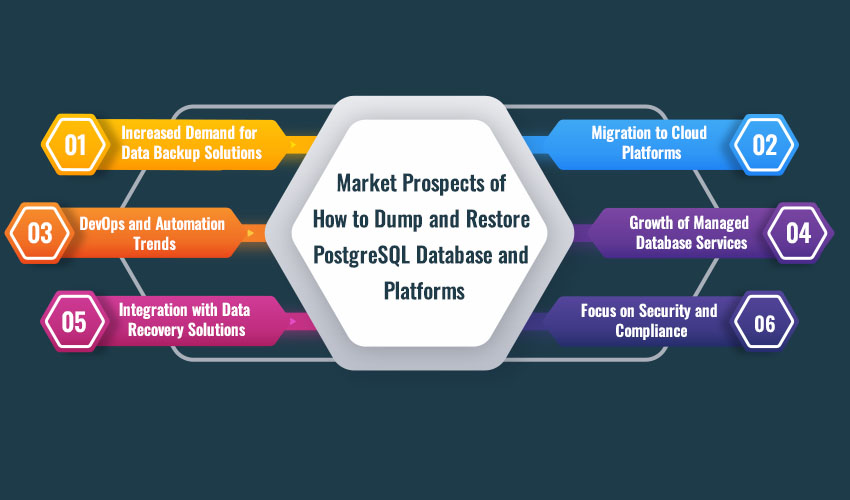Table of Contents
How to Dump and Restore PostgreSQL Database Services
Dumping and restoring PostgreSQL database services is an essential task for database administrators to ensure data integrity, backup, and recovery. Whether you’re migrating to a new server, upgrading PostgreSQL versions, or simply safeguarding against data loss, knowing how to effectively dump and restore databases is crucial. In this guide, we’ll walk through the process step by step.
Dumping PostgreSQL Database
Dumping a PostgreSQL database involves exporting its data and schema into a single file that can be used for backup or migration purposes. Follow these steps to perform a database dump:
- Access Command Line: Open a terminal or command prompt on your PostgreSQL server or client machine.
- Use pg_dump Command: Execute the
pg_dumpcommand followed by the name of the database you want to dump. Optionally, specify additional parameters such as username, host, and port if necessary - Provide Password (if required): If PostgreSQL authentication requires a password, you’ll be prompted to enter it after executing the command.
- Wait for Dump Process: Depending on the size of your database, the dump process may take some time. Once completed, you’ll have a SQL file containing the database schema and data.
Restoring PostgreSQL Database
Restoring a PostgreSQL database involves recreating the database schema and importing the data from a previously created dump file. Follow these steps to restore a database:
- Access Command Line: Open a terminal or command prompt on your PostgreSQL server or client machine.
- Use psql Command: Execute the
psqlcommand followed by the name of the target database you want to restore into. - Provide Password (if required): If PostgreSQL authentication requires a password, you’ll be prompted to enter it after executing the command.
- Wait for Restore Process: The restoration process will recreate the database schema and import the data from the dump file. Once completed, you’ll receive a confirmation message.
Tips for Successful Dump and Restore
- Regular Backups: Schedule regular database dumps to ensure data continuity and minimize the risk of data loss.
- Testing Backups: Periodically test your backup files by restoring them into a separate environment to verify their integrity.
- Use Compression: Consider compressing your dump files to reduce storage space and speed up data transfer.
- Secure Storage: Store backup files in a secure location, preferably off-site, to protect against hardware failures or disasters.
How to Create a How to Dump and Restore PostgreSQL Database
Dumping and restoring a PostgreSQL database is a crucial task for database administrators and developers alike. Whether you’re migrating data, backing up your database, or transferring it to another environment, knowing how to properly dump and restore a PostgreSQL database is essential. In this guide, we’ll walk you through the steps to create a dump of your PostgreSQL database and then restore it to another server.
Step 1: Dumping the PostgreSQL Database
- Access the Command Line: Open your terminal or command prompt.
- Navigate to PostgreSQL Bin Directory: If PostgreSQL is installed, navigate to its binary directory.
- Execute the pg_dump Command: Use the
pg_dumpcommand to create a dump of your PostgreSQL database. - Enter Password (if prompted): Depending on your PostgreSQL setup, you may need to enter your password to complete the dump.
- Verify Dump Completion: Once the command executes successfully, you should see a confirmation message in your terminal.
Step 2: Restoring the PostgreSQL Database
- Transfer the Dump File: If you’re restoring the database on another server, transfer the dump file (e.g.,
filename.sql) to that server using secure methods like SCP or SFTP. - Access the Command Line on the Target Server: Log in to the target server and open the terminal or command prompt.
- Navigate to PostgreSQL Bin Directory: Similar to the dumping process, navigate to the PostgreSQL binary directory on the target server.
- Execute the psql Command: Use the
psqlcommand to restore the dumped database. - Enter Password (if prompted): If password authentication is enabled, enter your password to initiate the restoration process.
- Verify Restoration: Once the command executes successfully, verify that the database has been restored by connecting to it and checking its contents.
Why Should You Go for How to Dump and Restore PostgreSQL Database
If you’re managing a PostgreSQL database, understanding how to dump and restore it is essential for data backup, recovery, and migration purposes. Dumping a PostgreSQL database involves extracting its data and schema into a plain-text file, while restoring it means recreating the database from the dump file. Here are some compelling reasons why you should familiarize yourself with this process:
- Data Backup: Regularly backing up your database is crucial for protecting against data loss due to hardware failures, software issues, or human error. Dumping the database allows you to create a snapshot of its current state, ensuring that you have a reliable backup to restore from in case of emergencies.
- Disaster Recovery: In the event of a catastrophic failure or data corruption, having a recent database dump enables you to quickly restore your data and minimize downtime. Without a backup, recovering lost data can be time-consuming and costly, potentially leading to business disruptions.
- Database Migration: When migrating your application to a new server or upgrading to a newer version of PostgreSQL, dumping and restoring the database is often the preferred method for transferring data. It ensures a smooth transition with minimal risk of data loss or compatibility issues.
- Testing and Development: Dumping a database allows you to create a replica of your production environment for testing, development, or debugging purposes. By restoring the dump file onto a different server or environment, developers can work with realistic data without impacting the production system.
- Selective Data Transfer: PostgreSQL’s dumping and restoring capabilities offer flexibility in transferring data between databases or servers. You can choose to dump specific tables, schemas, or even individual rows, allowing for selective data migration or synchronization between different environments.
- Version Control: Storing database dump files in version control systems such as Git provides a versioned history of your database schema and data changes over time. This can be invaluable for tracking changes, collaborating with team members, and rolling back to previous states if needed.
- Performance Optimization: Dumping and restoring databases can also help optimize database performance by reorganizing data, rebuilding indexes, and reclaiming disk space. This is particularly useful for large databases that have accumulated fragmentation or outdated statistics over time.
Market Prospects of How to Dump and Restore PostgreSQL Database and Platforms
In the world of database management, PostgreSQL stands out as a powerful and reliable open-source relational database system. Whether you’re a seasoned database administrator or a newcomer to the field, understanding how to dump and restore PostgreSQL databases is crucial for data backup, migration, and recovery purposes. In this article, we’ll explore the market prospects of tools, platforms, and solutions that facilitate the dumping and restoring of PostgreSQL databases.
1. Increased Demand for Data Backup Solutions: With the growing volume and complexity of data generated by businesses, the need for robust data backup solutions has become more pronounced. Dumping PostgreSQL databases allows organizations to create secure backups of their valuable data, ensuring protection against data loss due to hardware failures, human errors, or malicious attacks.
2. Migration to Cloud Platforms: Many businesses are migrating their PostgreSQL databases to cloud platforms like Amazon Web Services (AWS), Google Cloud Platform (GCP), and Microsoft Azure for improved scalability, reliability, and cost-effectiveness. Dumping and restoring databases are essential steps in this migration process, driving the demand for tools and services that streamline database migration to the cloud.
3. DevOps and Automation Trends: The adoption of DevOps practices and automation tools has reshaped the landscape of database management. DevOps teams seek efficient ways to automate database tasks, including dumping and restoring PostgreSQL databases, to accelerate deployment cycles and ensure consistent data environments across development, testing, and production stages.
4. Growth of Managed Database Services: Managed database services, offered by cloud providers and third-party vendors, are gaining traction among businesses looking to offload the burden of database management. These services often include built-in features for database backup, restoration, and replication, simplifying the process for users. As the demand for managed PostgreSQL services grows, so does the market for tools and platforms that support database dumping and restoration within these environments.
5. Integration with Data Recovery Solutions: Data recovery is a critical aspect of database management, especially in scenarios involving accidental data deletion, corruption, or system failures. Tools and platforms that support PostgreSQL database dumping and restoration play a vital role in data recovery strategies, enabling organizations to quickly recover lost or corrupted data and minimize downtime.
6. Focus on Security and Compliance: In an era of increasing data breaches and regulatory scrutiny, security and compliance have become top priorities for businesses handling sensitive information. Database dumping and restoration processes must adhere to security best practices and regulatory requirements to safeguard data integrity and confidentiality. As a result, the market for secure and compliant database backup solutions continues to expand.
Essential Features of a How to Dump and Restore PostgreSQL Database
PostgreSQL is a popular open-source relational database management system (RDBMS) known for its reliability, scalability, and extensibility. Dumping and restoring databases are essential tasks for database administrators to backup, transfer, and restore data. In this article, we will discuss the essential features of how to dump and restore a PostgreSQL database.
- pg_dump and pg_restore Commands: PostgreSQL provides built-in utilities called pg_dump and pg_restore for dumping and restoring databases, respectively. These commands allow you to create a consistent snapshot of a database and restore it later.
- Dumping a Database: To dump a PostgreSQL database, you can use the pg_dump command followed by the name of the database you want to dump. Additionally, you can specify various options such as the output file format, compression, and schema-only dump.
- Customizable Dump Options: pg_dump provides various options to customize the dump process according to your requirements. For example, you can choose to dump only specific schemas, tables, or data types. You can also include or exclude certain objects from the dump.
- Backup Compression: PostgreSQL allows you to compress the dump output using compression algorithms like gzip or custom compression formats. Compressing the dump can significantly reduce the file size, making it easier to transfer and store backups.
- Parallel Dumping: PostgreSQL 9.6 and later versions support parallel dumping, which allows you to dump multiple database objects simultaneously, improving performance and reducing the overall dump time.
- Dumping Large Databases: For large databases, it’s essential to optimize the dump process to minimize downtime and resource usage. PostgreSQL provides features like parallel dumping, custom compression, and incremental backups to efficiently handle large datasets.
- Restoring a Database: Once you have a dump file, you can restore the database using the pg_restore command. Similar to pg_dump, pg_restore offers various options for restoring databases, including parallel restoration, schema-only restoration, and custom options.
- Point-in-Time Recovery: PostgreSQL supports point-in-time recovery (PITR), allowing you to restore a database to a specific point in time by applying transaction logs (WAL files) to a base backup. This feature is useful for recovering from accidental data loss or database corruption.
- Transaction Safety: When dumping and restoring databases, PostgreSQL ensures transactional consistency to maintain data integrity. It uses a combination of transaction logs and checkpoints to ensure that the database can be restored to a consistent state even in the event of a system failure.
- Testing Backups: It’s crucial to regularly test your database backups to ensure they are valid and can be successfully restored when needed. PostgreSQL provides tools and utilities for testing backups and verifying data integrity, such as pg_dumpall, pg_verifybackup, and pg_isready.
Advanced Features of a How to Dump and Restore PostgreSQL Database
Dumping and restoring a PostgreSQL database is a crucial task for database administrators, especially when migrating data, backing up, or recovering from a system failure. PostgreSQL provides various advanced features to streamline this process, ensuring data integrity and efficiency. Let’s explore some of these advanced features in detail:
- Parallel Dump and Restore: PostgreSQL allows parallel execution of dump and restore operations, significantly reducing the time required for large databases. With parallelism, multiple connections can be established to the database server, enabling concurrent data transfer. This feature utilizes the available system resources efficiently, making the process faster and more scalable.
- Customizable Output Formats: PostgreSQL supports multiple output formats for database dumps, including plain text, custom, directory, and TAR format. Administrators can choose the appropriate format based on their requirements, such as compatibility with other database systems, compression efficiency, or ease of parsing. Additionally, custom dump formats provide flexibility in selecting specific database objects or data subsets for extraction.
- Point-In-Time Recovery (PITR): Point-in-time recovery allows administrators to restore a database to a specific transaction or timestamp, enabling precise data recovery up to the desired moment. PostgreSQL’s PITR feature utilizes the Write-Ahead Logging (WAL) mechanism to archive transaction logs, ensuring a consistent database state across backups. This capability is invaluable for recovering from accidental data deletion or corruption without losing recent changes.
- Continuous Archiving and WAL Shipping: PostgreSQL supports continuous archiving of WAL files, which are essential for maintaining a reliable backup and replication infrastructure. By continuously shipping WAL segments to an archival storage location, administrators can ensure data durability and minimize data loss in the event of a disaster. Combined with streaming replication, WAL shipping enables real-time backup synchronization and high availability configurations.
- Incremental Backup and Restore: PostgreSQL offers incremental backup capabilities, allowing administrators to capture only the changes since the last backup operation. Incremental backups save storage space and reduce backup windows by focusing on the modified data blocks, rather than duplicating the entire database contents. When restoring from incremental backups, PostgreSQL efficiently applies the incremental changes to reconstruct the database state at the desired point in time.
- Backup Encryption and Compression: PostgreSQL supports data encryption and compression during the dump and restore process, enhancing security and optimizing storage utilization. Administrators can encrypt backup files to protect sensitive data from unauthorized access, leveraging industry-standard encryption algorithms and key management practices. Additionally, compression techniques reduce the size of backup files, minimizing storage requirements and optimizing network transfer speeds.
How to Dump and Restore PostgreSQL Database Timelines
Dumping and restoring PostgreSQL database timelines can be a crucial task for database administrators to ensure data integrity, security, and reliability. Whether you’re migrating data to a new server, recovering from a disaster, or simply maintaining backups, understanding the process is essential. In this guide, we’ll walk you through the steps to dump and restore PostgreSQL database timelines effectively.
Dumping PostgreSQL Database Timelines
Dumping a PostgreSQL database involves creating a text file with SQL commands that can recreate the database’s schema and data. Here’s how to do it:
- Accessing the Command Line: Open your terminal or command prompt.
- Using pg_dump Command: PostgreSQL provides a utility called
pg_dumpfor creating backups. - Dumping Specific Timelines: If you want to dump specific timelines, you can use the
--create --format=custom --no-owner --no-aclflags along with the-tflag followed by the table name. - Verify the Dump: Once the dump process completes, verify the backup file to ensure it contains the necessary data.
Restoring PostgreSQL Database Timelines
Restoring a PostgreSQL database from a dump file is the process of recreating the database and importing the data. Here’s how to do it:
- Accessing the Command Line: Open your terminal or command prompt.
- Using pg_restore Command: PostgreSQL provides a utility called
pg_restorefor restoring backups. Use the following syntax to restore a database: - Restoring Specific Timelines: If you want to restore specific timelines, you can use the
-tflag followed by the table name. - Verify the Restoration: After the restoration process completes, verify the database to ensure that the data has been successfully imported.
How Much Does It Cost to Build a How to Dump and Restore PostgreSQL Database?
Dumping and restoring PostgreSQL databases are essential tasks for database administrators, allowing them to backup and recover critical data. However, many individuals and businesses may wonder about the costs involved in setting up such a system. Let’s explore the various factors that contribute to the overall cost of building a PostgreSQL database backup and recovery solution.
- Infrastructure Costs: The first consideration is the infrastructure required to host your PostgreSQL database. This includes servers, storage, and networking equipment. The cost can vary significantly depending on whether you choose to host your database on-premises or in the cloud. Cloud providers like Amazon Web Services (AWS), Google Cloud Platform (GCP), and Microsoft Azure offer scalable solutions with pay-as-you-go pricing models, which can be more cost-effective for many businesses.
- Database Size: The size of your database will also impact the cost. Larger databases require more storage space and may necessitate higher performance infrastructure to ensure efficient backup and restore operations. Some cloud providers charge based on the amount of data stored, so it’s essential to consider the size of your database when estimating costs.
- Backup Frequency: How frequently you need to backup your PostgreSQL database will affect the cost. More frequent backups require additional storage space and computing resources. Additionally, some backup solutions offer advanced features like continuous data protection or incremental backups, which may come with added costs.
- Retention Period: The retention period refers to how long you need to retain backup copies of your PostgreSQL database. Longer retention periods require more storage space and may increase costs. It’s essential to balance your retention requirements with your budget and compliance obligations.
- Backup and Restore Software: There are various backup and restore solutions available for PostgreSQL, ranging from open-source tools to commercial software with advanced features. The cost of these solutions can vary based on factors such as licensing models, support options, and additional features. Some businesses may opt for free or open-source solutions to minimize costs, while others may prioritize features and reliability and invest in commercial software.
- Labor Costs: Finally, labor costs should be considered when calculating the overall cost of building a PostgreSQL database backup and restore solution. This includes the time and expertise required to set up and maintain the system, monitor backups, perform restores, and troubleshoot any issues that arise. Depending on your organization’s resources and expertise, you may handle these tasks internally or outsource them to a third-party provider, which will impact costs accordingly.
How to Dump and Restore PostgreSQL Database Process
Dumping and restoring a PostgreSQL database is a crucial process for database administrators, developers, and anyone involved in managing databases. Whether you’re migrating data to a new server, backing up your database, or recovering from a disaster, understanding how to effectively dump and restore PostgreSQL databases is essential. In this guide, we’ll walk through the step-by-step process to accomplish this task seamlessly.
Dumping a PostgreSQL Database:
Dumping a PostgreSQL database involves extracting its contents into a file that can be easily transferred or backed up. Follow these steps to dump a PostgreSQL database:
- Access the Command Line: Open your terminal or command prompt.
- Navigate to PostgreSQL Bin Directory: Change directory to where PostgreSQL’s binaries are located. This is typically in the
bindirectory within your PostgreSQL installation. - Use the pg_dump Command: Once in the correct directory, use the
pg_dumpcommand followed by the name of the database you want to dump. - Enter Password (if prompted): Depending on your PostgreSQL configuration, you may be prompted to enter your password.
- Verify Dump Completion: Once the command executes successfully, you’ll have a SQL file containing the dumped contents of your database.
Restoring a PostgreSQL Database:
Restoring a dumped PostgreSQL database involves recreating the database from the dump file. Here’s how to do it:
- Access the Command Line: Open your terminal or command prompt.
- Navigate to PostgreSQL Bin Directory: Just like in the dumping process, navigate to the
bindirectory within your PostgreSQL installation. - Use the psql Command: Once in the correct directory, use the
psqlcommand followed by the name of the database you want to restore to and the path to the dump file. - Enter Password (if prompted): If required, enter your password to proceed with the restoration process.
- Verify Restoration: Once the command executes successfully, your database will be restored to its previous state as per the dump file.
How to Create a How to Dump and Restore PostgreSQL Database – Team and Tech Stack
Dumping and restoring a PostgreSQL database is a crucial task for any development team working with this powerful relational database management system (RDBMS). Whether you’re migrating data, creating backups, or deploying updates, understanding how to efficiently dump and restore a PostgreSQL database is essential. In this guide, we’ll walk through the process step by step, and also discuss the team and tech stack that can streamline this operation.
Understanding PostgreSQL Dump and Restore
Dumping a PostgreSQL database involves exporting its schema and data into a single file, typically with the extension .sql. This file contains SQL commands that can recreate the database’s structure and populate it with the data from the original database. Restoring, on the other hand, is the process of taking this dumped file and recreating the database based on its contents.
Step-by-Step Guide:
- Dumping the Database:
- Use the
pg_dumpcommand-line tool to dump the database. - Syntax:
pg_dump -U username -d dbname -f filename.sql - Replace
usernamewith your PostgreSQL username,dbnamewith the name of your database, andfilename.sqlwith the desired output file name.
- Use the
- Restoring the Database:
- Utilize the
psqlcommand-line tool to restore the dumped database. - Syntax:
psql -U username -d dbname -f filename.sql - Replace
username,dbname, andfilename.sqlwith the appropriate values.
- Utilize the
- Team Collaboration:
- Collaborate with your team to ensure everyone understands the database dump and restore process.
- Assign roles and responsibilities for database management tasks, including dumping and restoring databases.
- Tech Stack for Automation:
- Implement a tech stack that facilitates the automation of database management tasks.
- Use scripting languages like Python or Bash to create scripts that automate the dumping and restoring process.
- Integrate version control systems like Git to track changes to database schemas and scripts.
- Continuous Integration and Deployment (CI/CD):
- Incorporate database dumping and restoring into your CI/CD pipelines.
- Automate the process of dumping databases before deploying updates and restoring them as needed.
- Monitoring and Alerting:
- Implement monitoring and alerting systems to notify your team of any issues with database dumping or restoration.
- Monitor disk space usage to ensure sufficient storage for dumped files.
- Documentation and Training:
- Document the database dump and restore process for future reference.
- Provide training sessions for team members to familiarize them with the process and tools involved.
Next Big Technology – Your Trusted How to Dump and Restore PostgreSQL Database Partner
In the world of technology, staying ahead of the curve is essential for businesses to remain competitive. As new advancements continue to reshape the landscape, having a trusted partner to navigate these changes becomes increasingly valuable. When it comes to managing databases, PostgreSQL stands out as a reliable and powerful option. And with the next big technology wave on the horizon, having a partner you can trust to handle tasks like dumping and restoring databases is crucial.
Introducing Your Trusted How to Dump and Restore PostgreSQL Database Partner – a reliable solution for businesses looking to leverage the power of PostgreSQL while ensuring seamless data management. With expertise in PostgreSQL database administration, backup, and recovery, our team is equipped to handle all your database needs with precision and efficiency.
Dumping and restoring databases are critical operations that require careful attention to detail. Whether you’re migrating data to a new server, recovering from a disaster, or simply backing up your data for peace of mind, having a partner who knows the ins and outs of PostgreSQL is invaluable.
So, why choose us as your trusted partner for dumping and restoring PostgreSQL databases? Here are a few reasons:
- Expertise: Our team consists of skilled professionals with years of experience in PostgreSQL database administration. We understand the intricacies of the platform and can efficiently handle tasks like dumping and restoring databases with ease.
- Reliability: When it comes to your data, trust is non-negotiable. We take the security and integrity of your information seriously, implementing best practices to ensure that your data is safe and accessible when you need it most.
- Efficiency: Time is of the essence, especially when dealing with database operations. Our streamlined processes and efficient workflows enable us to complete tasks quickly and accurately, minimizing downtime and maximizing productivity.
- Customization: We understand that every business has unique needs and requirements. That’s why we offer customized solutions tailored to your specific situation. Whether you need a one-time database dump or ongoing support, we’ve got you covered.
- Support: Our commitment to customer satisfaction extends beyond the initial engagement. We provide ongoing support and assistance to ensure that your PostgreSQL databases continue to run smoothly long after the dumping and restoring process is complete.
Enterprise How to Dump and Restore PostgreSQL Database
Dumping and restoring a PostgreSQL database is a critical task for enterprise environments, whether it’s for backup purposes, migrating data to a new server, or recovering from a disaster. PostgreSQL provides powerful tools to accomplish this task efficiently. In this guide, we’ll walk through the steps to dump and restore a PostgreSQL database.
Dumping a PostgreSQL Database
Dumping a PostgreSQL database involves exporting its data and schema to a file that can be later used to restore the database. The pg_dump command-line tool is typically used for this purpose. Here’s how to do it:
- Open Command Line Interface: Access your terminal or command prompt.
- Navigate to PostgreSQL Bin Directory (Optional): If PostgreSQL bin directory is not in your system’s PATH, navigate to it using the
cdcommand. - Run
pg_dumpCommand: Use thepg_dumpcommand followed by the database name to dump the database to a file. You may also specify additional options such as the format of the dump file and compression. - Provide Password (if required): If PostgreSQL authentication requires a password, you’ll be prompted to enter it after executing the
pg_dumpcommand. - Verify Dump File: Once the command completes, verify that the dump file (
filename.sql) has been created in the specified location.
Restoring a PostgreSQL Database
Restoring a PostgreSQL database involves recreating the database structure and importing data from a previously dumped file. The psql command-line tool is used for this purpose. Here’s how to do it:
- Open Command Line Interface: Access your terminal or command prompt.
- Navigate to PostgreSQL Bin Directory (Optional): If PostgreSQL bin directory is not in your system’s PATH, navigate to it using the
cdcommand. - Run
psqlCommand: Use thepsqlcommand followed by the name of the database where you want to restore the dump file. - Provide Password (if required): If PostgreSQL authentication requires a password, you’ll be prompted to enter it after executing the
psqlcommand. - Verify Restoration: Once the command completes, verify that the database has been restored successfully by accessing it through a PostgreSQL client or checking its contents.
Top How to Dump and Restore PostgreSQL Database Company
In the realm of database management, PostgreSQL stands out as one of the most powerful and versatile systems available. Whether you’re a seasoned database administrator or just starting your journey with PostgreSQL, understanding how to effectively dump and restore databases is essential. In this guide, we’ll delve into the intricacies of dumping and restoring PostgreSQL databases, ensuring that your data remains secure and accessible at all times.
-
Next Big Technology:

Focus Area
- Mobile App Development
- App Designing (UI/UX)
- Software Development
- Web Development
- AR & VR Development
- Big Data & BI
- Cloud Computing Services
- DevOps
- E-commerce Development
Industries Focus
- Art, Entertainment & Music
- Business Services
- Consumer Products
- Designing
- Education
- Financial & Payments
- Gaming
- Government
- Healthcare & Medical
- Hospitality
- Information Technology
- Legal & Compliance
- Manufacturing
- Media
Step-by-Step Guide to Dumping a PostgreSQL Database:
- Accessing the PostgreSQL Command Line Interface: Begin by opening your terminal or command prompt and accessing the PostgreSQL command line interface using the ‘psql’ command.
- Selecting the Database: Once in the PostgreSQL command line interface, select the database you wish to dump using the ‘\c’ command followed by the database name.
- Generating the Dump File: With the desired database selected, generate the dump file using the ‘pg_dump’ command. Specify the name of the database and the output file using appropriate flags, such as ‘-f’ for the file name.
- Verifying the Dump: After the dump process completes, verify the integrity of the dump file to ensure that it contains the necessary SQL commands to recreate the database structure and data.
Step-by-Step Guide to Restoring a PostgreSQL Database:
- Accessing the PostgreSQL Command Line Interface: Similarly, access the PostgreSQL command line interface using the ‘psql’ command in your terminal or command prompt.
- Creating a New Database (Optional): If you’re restoring the database to a new instance or want to use a different name, create a new database using the ‘CREATE DATABASE’ command.
- Restoring the Database: Execute the SQL commands stored in the dump file using the ‘\i’ command followed by the path to the dump file. This process will recreate the database structure and import the data from the dump file.
- Verifying the Restoration: Once the restoration process completes, verify the database’s integrity by querying its tables and comparing the data with the original database.
Best Practices for Dumping and Restoring PostgreSQL Databases:
- Regular Backups: Schedule regular database backups to ensure that you always have up-to-date dump files available for restoration in case of data loss or corruption.
- Encryption: Consider encrypting your dump files to protect sensitive data during transit and storage, especially if you’re transferring them over a network.
- Testing: Before relying on dump files for disaster recovery scenarios, periodically test the restoration process to identify any potential issues or inconsistencies.
- Documentation: Maintain comprehensive documentation outlining your database dumping and restoration procedures, including any custom configurations or scripts utilized.
Add Comparison Table How to Dump and Restore PostgreSQL Database
PostgreSQL is a powerful open-source relational database management system known for its reliability and robust features. Dumping and restoring databases are common tasks for database administrators to backup, migrate, or clone databases. In this guide, we’ll walk through the process of dumping and restoring a PostgreSQL database.
Dumping a PostgreSQL Database:
Dumping a PostgreSQL database involves exporting its data and schema to a file, typically in SQL format. This file can then be used to recreate the database or restore its contents elsewhere. Here’s how to do it:
- Using pg_dump:
- The
pg_dumputility is the standard tool for dumping PostgreSQL databases. It connects to a PostgreSQL database and generates a SQL script that contains the database’s schema and data. - Syntax:
pg_dump -U username -d dbname > dumpfile.sql - Replace
usernamewith your PostgreSQL username,dbnamewith the name of the database you want to dump, anddumpfile.sqlwith the desired filename for the dump file.
- The
- Dumping Schema Only:
- If you only need to dump the schema without data, you can use the
-sor--schema-onlyoption withpg_dump. - Syntax:
pg_dump -U username -d dbname -s > schema.sql
- If you only need to dump the schema without data, you can use the
- Dumping Specific Tables:
- To dump specific tables instead of the entire database, you can use the
-tor--tableoption followed by the table name. - Syntax:
pg_dump -U username -d dbname -t tablename > table_dump.sql
- To dump specific tables instead of the entire database, you can use the
Restoring a PostgreSQL Database:
Restoring a PostgreSQL database involves recreating a database from a dump file. This process is essential for recovering data or migrating databases to new servers. Here’s how to do it:
- Using psql:
- The
psqlutility is the standard PostgreSQL client for executing SQL commands. It can be used to restore a database from a dump file. - Syntax:
psql -U username -d dbname < dumpfile.sql - Replace
usernamewith your PostgreSQL username,dbnamewith the name of the target database, anddumpfile.sqlwith the path to the dump file.
- The
- Restoring Schema Only:
- If you only want to restore the schema without data, you can use the
-sor--schema-onlyoption withpsql. - Syntax:
psql -U username -d dbname -1 -f schema.sql
- If you only want to restore the schema without data, you can use the
- Restoring Specific Tables:
- To restore specific tables from a dump file, you can use the
-tor--tableoption followed by the table name withpsql. - Syntax:
psql -U username -d dbname -1 -f table_dump.sql
- To restore specific tables from a dump file, you can use the
Comparison Table:
Here’s a comparison table summarizing the differences between dumping and restoring a PostgreSQL database:
| Aspect | Dumping | Restoring |
|---|---|---|
| Purpose | Export database schema and data | Recreate database from dump file |
| Utility | pg_dump | psql |
| Output Format | SQL | SQL |
| Schema Only | Yes | Yes |
| Data Only | No | No |
| Specific Tables | Yes | Yes |
| Command Syntax | pg_dump -U username -d dbname > file | psql -U username -d dbname < file |
FAQs on How to Dump and Restore PostgreSQL Database
If you’re new to managing PostgreSQL databases, you might have some questions about how to dump and restore data. Backing up and restoring databases is a crucial aspect of database administration, ensuring that you can recover data in case of accidental deletion, corruption, or other issues. Here are some frequently asked questions (FAQs) about dumping and restoring PostgreSQL databases:
- What is dumping and restoring in PostgreSQL? Dumping refers to the process of exporting the contents of a database into a text file using the
pg_dumputility. Restoring, on the other hand, involves importing the data from a dump file back into a PostgreSQL database using thepg_restoreutility. - How do I dump a PostgreSQL database? To dump a PostgreSQL database, you can use the
pg_dumpcommand-line tool. - What options can I use with pg_dump?
-U: Specifies the username to connect to the database.--format: Specifies the format of the output file (e.g.,plain,custom,directory).--file: Specifies the output file to dump the database to.--no-owner: Excludes ownership information from the dump.--no-acl: Excludes access control lists (ACLs) from the dump.
- How do I restore a PostgreSQL database from a dump file? To restore a PostgreSQL database from a dump file, you can use the
pg_restorecommand-line tool. - What options can I use with pg_restore?
-U: Specifies the username to connect to the database.-d: Specifies the name of the database to restore into.--clean: Drops existing objects in the target database before restoring.--create: Creates the target database before restoring into it.--format: Specifies the format of the input file (e.g.,plain,custom,directory).
- Can I dump and restore specific tables or schemas? Yes, you can use the
-tor-noptions withpg_dumpto dump specific tables or schemas, and the-toption withpg_restoreto restore only specific tables. - How often should I perform database dumps? It’s recommended to perform regular database dumps, depending on the criticality of your data and the frequency of updates. Many organizations perform daily or weekly backups to ensure data integrity.
- Where should I store my database dump files? Store your database dump files in a secure location, preferably on a different server or storage device to protect against data loss due to hardware failures or disasters.
Thanks for reading our post “How to Dump and Restore PostgreSQL Database”. Please connect with us to learn more about the Top How to Dump and Restore PostgreSQL Database.














